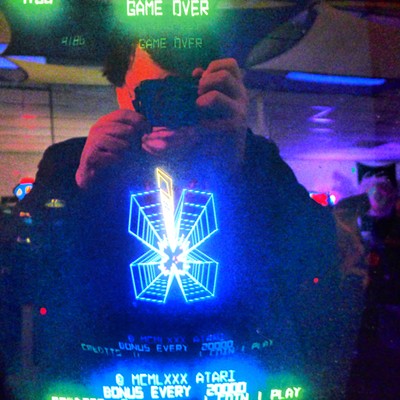In 2007 Carcass returned and now it has embarked on its first international tour in nearly twenty years. We spoke with singer/bassist Jeff Walker about how he came to design the cover art to Napalm Death's Scum, how he ended up on an episode of Red Dwarf and why Carcass re-recorded rather than remixed songs by other artists.
Westword: You were very young when you were in Electro Hippies. How did you get into playing that kind of music back then?
Jeff Walker: I kind of grew up with what we call classic rock now and I drifted off into stuff like Sex Pistols. From that I went into faster and harder punk rock and then American hardcore. Electro Hippies was really a crossover band. It was heavily influenced by bands like Siege from Boston and Dirty Rotten Imbeciles from Houston and Millions of Dead Cops from Austin. It was that mixed with bands like Slayer and other thrash metal. I guess I was just at the age. I was sixteen or seventeen when I was in that band and that was just the music I liked. I was also getting back into metal and at that point metal had become harder and heavier compared to what I was listening to in the late 70s and the early 80s like Thin Lizzy and Rainbow.
You played guitar in that band, how did you get into playing bass for Carcass?
I was just a vocalist. I tried to learn guitar as a kid. As you know, every bass player is just a failed guitar player. Just as every music journalist is a failed musician, you know? When I got kicked out of that band I was asked by another band that hard heard I'd played the bass and they asked me to join. Playing the bass was easier than trying to play the guitar.
Were there any bassists you looked up to?
Probably Steve Jones from the Sex Pistols. He played bass on the album, Nevermind The Bollocks, Here's the Sex Pistols. That's a fantastic sounding record. Now I'm old, of course, and now I respect the usual people like Entwistle or whatever. But I'm not really musicians' musician. I don't really classify myself as a musician. I really don't take myself that seriously. For me it's a trade-off because I've got to do the vocals as well and something's got to give and something's got to suffer and unfortunately it's both things in my case.
You created the iconic album art for Napalm Death's 1987 album, and one of the founding documents of grindcore, Scum. How did that come about and what inspired that piece?
What it was is that Bill Steer, who was in Carcass, had a fanzine at the time and I drew a picture for that. Mick Harris, the drummer in Napalm, who I was friends with at the time anyway asked if I could do a cover for Scum. Basically I was given a brief from him that Nick Bullen had given to him and it was the typical, anarcho, crappy, post-Crass idea. He wanted starving people with business men, crooked skulls and mini corporate logs.
So I started to work on that but then I drew in what I thought would be cool because I'd heard that Justin [Broadrick] described what we do and it was spot on. The A-side of Scum is basically Celtic Frost meets Siege. If you look at the picture, the skulls at the bottom are off a Siege flyer. And the Angel of Death is basically the Celtic Frost logo, the old one with the wings, but made into a creature. I really tried to encapsulate that. I metalized, or tried to make cooler, what I thought was a cliché, crusty punk idea.
Had you already seen Napalm Death at that point?
Oh yeah. I was in a band that was faster than Napalm Death. At that time Napalm Death still sounded like Killing Joke. I saw Napalm Death in Birmingham and I was blown away. I also saw Heresy, which was a thrash band from that period. Napalm Death blew me away because I liked the heavy bits and the speedy bits but they looked cool as well. They had this kind of typical, for that time, punk rock look but it was almost a fascistic look--that post Crass look where everyone is wearing black. They just looked cool. Whereas my band did not look cool. I was just jealous. There was no humor to it. Well there was but it was more quasi-fascistic. They looked more intense.
That was probably when Justin Broadrick was in the band.
Mm hm. It was a three piece with Bullen, Justin and Mick Harris. You appeared in an episode of Red Dwarf as a member of Smeg and the Heads. How did that come together?
That line-up of Napalm Death when it was Bill, Lee Dorian, Mick Harris and Shane Embury got invited onto a children's TV program, of all things, on the BBC. This guy called Craig Charles had this show called What's That Noise?. Craig is from our neck of the woods, from around Liverpool, and I guess he had a soft spot for Napalm Death. He invited two musicians from that band to go on the show and Mick and Shane, for whatever reason, didn't want to do it. And then [a couple of guys from Earache at the time] wanted to do it and be on the program. But in order to do it you needed musician's union memberships and they didn't have it. Basically we were the last option. Bill had just quit Napalm Death so there was the connection there. I guess they wanted Napalm Death but couldn't get them and unfortunately for them they got me and Bill instead.
Carcass re-recorded songs by Bjork and Killing Joke when you were approached about doing a remix. Why did you go the route of re-recording the songs rather than go with a more traditional remix?
Back then, even though technology like ProTools existed, we didn't come across it ourselves. We'd seen samplers and actually used them on some records. Remixing as you know it now wasn't as easy back then. The only way I knew how to do it was to commit it to tape. It's not like nowadays when you could do it on GarageBand on your laptop. Pro Tools was cumbersome and would take hours to render. What just took those songs and tried to re-interpret them in a Carcass style and all we really know is bass, guitar and drums. Call us conservative, call us Luddites, but that's the method we operate in.
What made the new material you wrote for Surgical Steel feel like a Carcass album for you?
It just sounds like Carcass. We're fortunate enough to have our own sound. Even given that we had influences we tried to emulate, we had our own style. I think of the guitar player. I'm not necessarily a fan of my own voice but you can definitely tell it's me. I actually think the vocals have improved since Heartwork or Swansong.
"The Granulating Dark Satanic Mills" sounds like a nod to William Blake's poem "Milton" and his comment on the deleterious effects of the industrial revolution. Was there a commentary you were making on the modern world in that song?
I spent ten years working in an office and I guess it's a song that's a result of the experience of rubbing shoulders with, for want of a better word, life. I'm from an industrial town anyway and it's an homage to the town I'm from.
"Noncompliance to ASTM F 899-12 Standard" is a reference to a standard for surgical steel. Is that a humorous way to refer to the title of the album?
Somewhat. No, I mean "316L Grade Surgical Steel" is more a reference to the album title. I think that song is a braggart song. It's kind of commenting on a few bands that we possibly influenced and how as much as they try they're not really reaching the same standard as Carcass. Call that arrogance or plucky but it's calling out imposters.
What did you learn to appreciate or re-appreciate about the music of Carcass that wasn't as obvious to you the first time around?
I never took as seriously as I do now. I appreciate people paying good money for tickets to see a concert or a CD. I think it's about realizing that our sole purpose is to make people happy. I definitely had selfish reasons for wanting to do it and I tend to put people's feelings before my own nowadays. I'm definitely more conscious that we arrive on time and that we're real and do our best. I want to do the name of the band justice. You don't want to read shitty reviews where people feel like we're doing things half-assed. There's more pressure to deliver now more than there ever was before. It means something to people and there's definitely more love for the band. Extremity in general has gotten bigger. I mean the culture is a lot harder-edged than it was fifteen or twenty years ago. What was shocking then, now if someone saw it they wouldn't flinch.
• BACKBEAT'S GREATEST HITS • - The fifty best rap lyrics of all time - The ten biggest concert buzzkills - Five more concert buzzkills - From Phish to Floyd, the ten best light shows
Follow @Westword_Music











